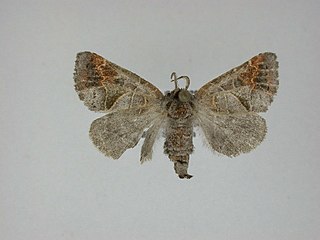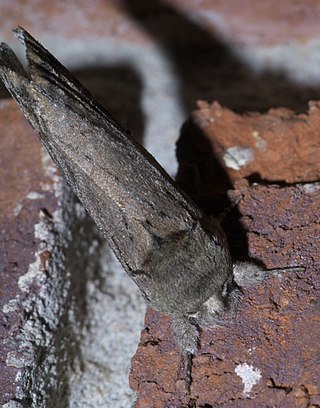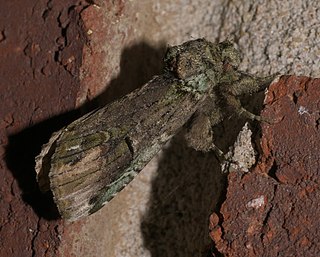
Notodontidae is a family of moths with approximately 3,800 known species. The family was described by James Francis Stephens in 1829. Moths of this family are found in all parts of the world, but they are most concentrated in tropical areas, especially in the New World.

Heterocampa is a genus of prominent moths in the family Notodontidae. There are about 18 described species in Heterocampa, found in North, Central, and South America.

Schizura is a genus of prominent moths in the family Notodontidae. There are about eight described species in Schizura.

Cecrita guttivitta, the saddled prominent moth, is a species of moth of the family Notodontidae. It is found in North America, including Alabama, Arkansas, Connecticut, Delaware, Florida, Georgia, Illinois, Indiana, Iowa, Kansas, Kentucky, Maine, Maryland, Massachusetts, Minnesota, New Brunswick, New Hampshire, New Jersey, New York, North Carolina, Ohio, Oklahoma, Ontario, Pennsylvania, South Carolina, Tennessee, Vermont, Virginia, West Virginia and Wisconsin.
Dicentria is a genus of moths of the family Notodontidae. The genus contains about 46 described species occurring from Mexico south to Bolivia and Paraguay. Its affinities to the North American genera Schizura and Oligocentria are not fully understood.

Heterocampinae is a subfamily of prominent moths in the family Notodontidae. There are at least 60 described species of Heterocampinae in North America.

Coelodasys apicalis, the plain schizura, is a species of moth in the family Notodontidae. It was first described by Augustus Radcliffe Grote and Coleman Townsend Robinson in 1866, and is found in North America.

Heterocampa obliqua, the oblique heterocampa or oblique prominent, is a species of moth in the family Notodontidae. It was first described by Alpheus Spring Packard in 1864 and it is found in North America.

Clostera apicalis, the apical prominent or red-marked tentmaker, is a species of moth in the family Notodontidae. It was first described by Francis Walker in 1855 and it is found in North America.
Heterocampa benitensis, the spring snowflake, is a species of moth in the family Notodontidae. It was first described by André Blanchard in 1971 and it is found in North America.
Heterocampa amanda is a species of moth in the family Notodontidae. It was first described by William Barnes and Arthur Ward Lindsey in 1921 and it is found in North America.

Cecrita lunata is a species of moth in the family Notodontidae. It was first described by Henry Edwards in 1884 and it is found in the western United States and Mexico.
Heterocampa varia, the sandplain heterocampa, is a species of moth in the family Notodontidae. Other common names include the alpine mouse-ear and white-marked heterocampa. It was first described by Francis Walker in 1855 and it is found in North America.

Heterocampa biundata, the wavy-lined heterocampa, is a species of moth in the family Notodontidae. It was first described by Francis Walker in 1855 and it is found in North America.
Heterocampa zayasi, the blue moor-grass moth or zaya heterocampa, is a species of moth in the family Notodontidae. It was first described by Torre and Alayo in 1959 and it is found in Cuba.

Oedemasia leptinoides, the black-blotched schizura or black-blotched prominent, is a species of moth in the family Notodontidae. It was first described by Augustus Radcliffe Grote in 1864 and is found in North America.
Cecrita belfragei is a species of moth in the family Notodontidae. It was first described by Augustus Radcliffe Grote in 1879 and it is found in North America.

Coelodasys is a genus of prominent moths in the family Notodontidae. There are at least four described species in Coelodasys, found in North America.

Oedemasia is a genus of prominent moths in the family Notodontidae. There are at least four described species in Oedemasia, found mainly in North America.













